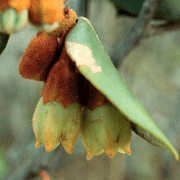James L. Luteyn and Paola Pedraza-Peñalosa
The New York Botanical Garden
|
|
Notopora is a genus of 5 secies, all endemic to the Guayana Highland region of Venezuela and adjacent Guyana. |
Terrestrial shrub. Leaves alternate, evergreen, congested, short-petiolate, the blade coriaceous, with the margins often strongly recurved; venation pinnate. Inflorescence axillary, the flowers solitary or in pairs, or 2-5-racemose. Flowers 5-merous; aestivation valvate; pedicel bibracteolate; calyx articulate with pedicel; hypanthium cylindric or campanulate; limb erect; corolla carnose, cylindric to urceolate-subcylindric; stamens 10, equal, nearly as long as corolla; filaments equal, elongate, longer than the anthers, at first weakly adherent to the corolla but soon free; anthers equal, basifixed; thecae strongly granular; tubules erect, distinct, slightly shorter than thecae, dehiscing by wide, extrorse clefts; style about as long as corolla. Fruit a berry.
Key to Neotropical Species Back to Top
1. Leaf blades orbicular to broadly suborbicular-ovate, rounded
at both ends.
2. Corolla red, glabrous without; calyx
essentially glabrous with only the lobes
ciliate; lower
leaf surface sparsely pilosulous to glabrate .............. N. cardonae.
2. Corolla pale green with copious pale
ferruginous tomentum; calyx
completely covered
by dense ferrruginous tomentum; lower leaf surface
densely ferruginous
tomentellose ............................................ N. chimantensis.
1. Leaf blades sublanceolate to ovate or narrowly suborbicular-ovate,
acute,
obtuse, or narrowed at one or both ends.
3. Corolla narrowly cylindric, dark
red; calyx glabrous; lower leaf surface
glabrous ...................................................................................
N. smithiana.
3. Corolla deeply campanulate-infundibuliform
to urceolate-subcylindric,
pale cream,
greenish-white, or salmon-rose; calyx densely tomentose;
lower leaf surface
with a close tomentum or softly pilose.
4. Lower
leaf surface dark rusty-brown or ferruginous to grayish-brown
with a dense tomentum; corolla pale cream or greenish-white, externally
uniformly densely pubescent; leaf blades acute to subacuminate at
apex
.......................................................................................
N. schomburgkii.
4. Lower
leaf surface pale green with sparse pubescence of minute,
trichomes; corolla salmon-rose, externally glabrous except for patches
of pubescence in upper half; leaf blades obtuse to subacute at apex
....................................................................................
N. auyantepuiensis.
This version comes from James Luteyn's unpublished notes. The reader is referred to tthe taxonomic treatment by Steyermark (1967).
